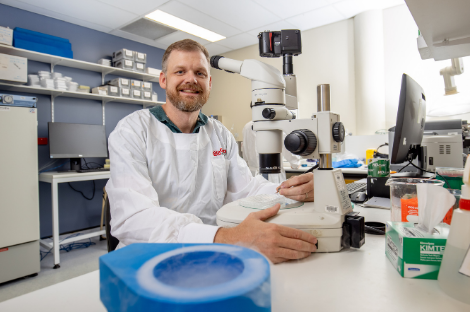Fighting neurodegenerative diseases through translational research
Neurodegenerative disease is the umbrella term used to describe a group of disorders that are characterised by the progressive degeneration of the structure and function of the central and peripheral nervous systems. This causes problems with movement or mental functioning.
Neurodegenerative disorders have been predicted by the World Health Organisation to overtake cancer and become the second-most prevalent cause of death in the next 20 years.
The science behind neurodegenerative diseases
Axons (nerve fibres) are the portion of the nerve cells that communicates with other cells by transmitting electrical and chemical signals. These signals underlie essential processes, such as thinking and memory, movement, language and sense of touch.
When axons are damaged, whether by injury, disease or as a side effect of certain drugs, a program is triggered to make axons self-destruct. This destruction likely plays an important role in multiple neurodegenerative conditions, including peripheral neuropathy, Parkinson's disease amyotrophic lateral sclerosis (ALS), traumatic brain injury and glaucoma. There are no current treatments that effectively target axonal breakdown.
Our unique research approach
Associate Professor Thomas Ve and team
The enzyme SARM1 is a central player in axon loss. In healthy nerve cells, SARM1 is present but inactive. Disease and injury activate SARM1, which results in rapid breakdown of the essential “helper molecule” nicotinamide adenine dinucleotide (NAD+) and ultimately destruction of the axon. Interestingly, similar NAD+ consuming enzymes are also found in bacterial immune systems that provide protection against viral (phage) infections.
SARM1 is a potential therapeutic target for many neurodegenerative diseases but, in order to exploit the full promise of targeting SARM1, detailed knowledge of the catalytic mechanism and the molecular mechanisms upstream and downstream of SARM1 enzyme activity is required.
Associate Professor Thomas Ve’s research group at the Institute for Glycomics is using structural biology methods such as cryo-EM and X-ray Crystallography, combined with cell and chemistry-based approaches through national and international collaborators, to characterise SARM1 and related bacterial enzymes at the molecular level; define how they are regulated; and explore the diversity and targets of their nucleotide signals.
The research will unravel general principles of nucleotide-based signalling across all domains of life and will lead to an improved understanding of the molecular mechanisms involved in SARM1 induced axon degeneration.
Importantly, the research will provide new strategies for design of targeted inhibitors of axon degeneration, which can be developed into therapeutic agents for neurodegenerative diseases.
Translation of this research is supported by a long-term research collaboration with Associate Professor Ve’s industry partner Disarm Therapeutics, a wholly-owned subsidiary of Eli Lilly and Company, whose mission is to create breakthrough disease-modifying therapeutics to treat patients affected by axonal degeneration.
Professor Carolyn Mountford and team
Professor Carolyn Mountford is a world leader in the development of magnetic resonance (MR) technology to address unmet clinical needs.
Her translational research in the neuro field centres on MR technology to identify changes to the brain associated with Post-Traumatic Stress Disorder (PTSD), injury from blast and impact, and pain. Her team is under contract to the USA and Australian military to develop this approach to improve the health of soldiers.
Professor Mountford’s research team uses clinical 3T scanners to monitor the effect of disease and pain on the human glycome. They have assigned seven fucosylated glycans in the human brain, which are affected differently by chronic pain, PTSD, and blast exposure. These Fuc-α(1−2) glycans have been shown in animal models by a Caltech team to be implicated in the mechanisms underlying neuronal development, learning and memory and regulation of the nervous system development and neuronal processes. Elucidating the precise carbohydrate chemistry that is underlying these conditions is integral to future clinical management.
Our experts

Associate Professor Thomas Ve
Associate Professor Thomas Ve is an ARC Future Fellow, a NHMRC Investigator, and a Research Leader at the Institute for Glycomics. He is an internationally recognised structural biologist with a demonstrated record in making novel discoveries that have had transformative impact on the infection and immunity field. His research in the neuro field focuses on structural biology and inhibition of axon (nerve fibre) degeneration, which is a hallmark of many neurodegenerative disease conditions including peripheral neuropathy, Parkinson's disease, amyotrophic lateral sclerosis (ALS), traumatic brain injury and glaucoma. Thomas graduated from University of Queensland in 2011 and joined Griffith University and the Institute for Glycomics in 2015.
Contact information:
- Phone: 07 5552 7012
- E-mail: t.ve@griffith.edu.au

Professor Carolyn Mountford
Professor Carolyn Mountford is a Principal Research Leader at the Institute for Glycomics and a world leader in the development of magnetic resonance (MR) technology to address unmet clinical needs. Her research in the neuro field focuses on Post-Traumatic Stress Disorder (PTSD), injury from blast and impact, and pain. Her research in the cancer field focuses on ovarian and breast cancer. Carolyn graduated with two degrees from Somerville College Oxford and was awarded full Professor of Radiology at Harvard Medical School in 2011.
Contact information:
- Phone: 07 5552 8051
- E-mail: carolyn.mountford@griffith.edu.au
Want to support our neurodegenerative diseases research?
Help us fight these debilitating disorders